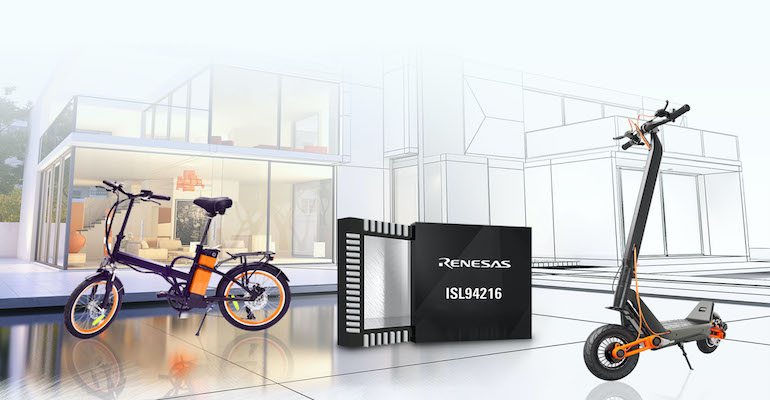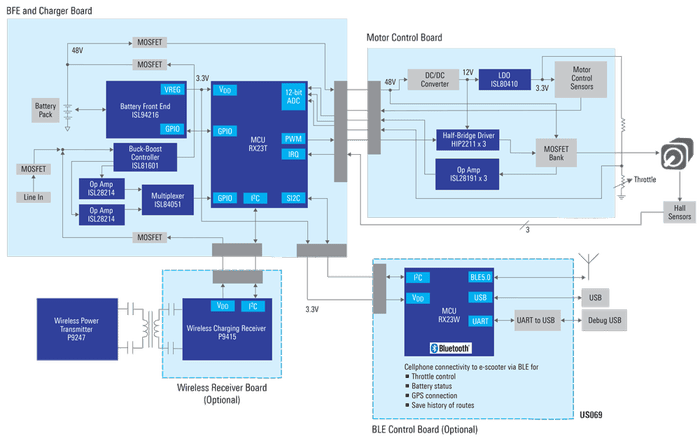The growing demand for micro-mobility vehicles requires a fresh look at battery management techniques to extend range and improve performance.
October 13, 2020

E-scooters and e-bikes are becoming the favorite low-carbon-footprint micro-mobility vehicle options for first-mile and last-mile travel. The rising demand for these applications has pushed developers to find better ways to incorporate new battery management capabilities as cell balancing plays an increasingly critical role in recharging.
To learn more about these performance and energy storage enhancements, Design News talked with DK Singh, Director, Systems and Solutions Team at Renesas. The company is a major provider in the world of analog, power, and embedded processing components and systems. Recently, Renesas introduced a 48V Mobility Winning Combination Solution, which is powered by a 25 AHr Li-ion battery that drives a 1600W inverter to attain speeds up to 5000 rpm. This new reference design uses a modular approach in both hardware and software to showcase core and optional functional blocks, which can also be adopted for many 24V-48V applications such as lawnmowers, electric carts, robot cleaners, power tools, power banks, and more.
DN: Are eScooters and eBikes really becoming a trend?
DK Singh: E-mobility is a growing segment with CAGR of ~5% and expected to be a $25B market by 2025. Other than the traditional markets of e-bikes or e-scooters, there are also other new applications appearing on many streets, such as small delivery carts.
DN: What are the elements of a power design for such systems, e.g., what type of battery, inverter, feedback mechanisms.
DK Singh: The present design is a modular one that can be adopted into different types of variant applications with some limiting conditions. For example, the current design uses a 25AH 28 battery, but this can be adopted into other lower-voltage batteries.
Software is a key part of the design as BLDC motors need sophisticated motor control algorithms. Renesas will provide the associated software to its customers.
The current design is optimized for 48V batteries, but it can be adopted into lower voltage designs. The system has a maximum limit of ~62V.
The reference design has an onboard Li-ion battery charger which has been implemented by a buck-boost controller and an MCU. The wireless charger presented in the reference design is an optional capability that can be implemented into the system for contactless charging to avoid mechanical wear and tear.
DN: Power management systems typically rely on software to achieve energy efficiency. But that means adding additional electronics as well as replacing analog components. Wouldn’t the additions of a microcontroller, memory, and interfaces lead to greater overall power consumption?
DK Singh: A major part of the power efficiency is achieved through the right selection of the topology, control architecture, and power devices. Further optimization is done by schematic and layout design and the implementation of the right power supply control. In this particular design, we are using a single MCU for motor control and overall system management. Interface or additional devices such as wireless chargers or mobile apps are optional and can be removed completely to avoid any kind of redundancy.
DN: What is the user interface like for eScooters and eBikes? Does it work through a mobile phone app?
DK Singh: A mobile app is an optional function for any sort of commercial use or for somebody who likes to engage and analyze the scooter from the phone. For example, in a rental e-bike application, it can help with authorization. This function is completely independent and can be removed; it is not required to reduce the system cost.
|
Functional block diagram for the 48v mobility system. (Image Source: Renesas, 48v Mobility) |
John Blyler is a Design News senior editor, covering the electronics and advanced manufacturing spaces. With a BS in Engineering Physics and an MS in Electrical Engineering, he has years of hardware-software-network systems experience as an editor and engineer within the advanced manufacturing, IoT and semiconductor industries. John has co-authored books related to system engineering and electronics for IEEE, Wiley, and Elsevier.
About the Author(s)
You May Also Like






